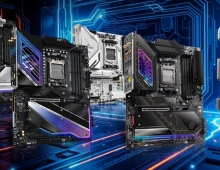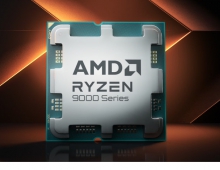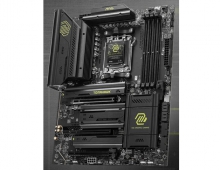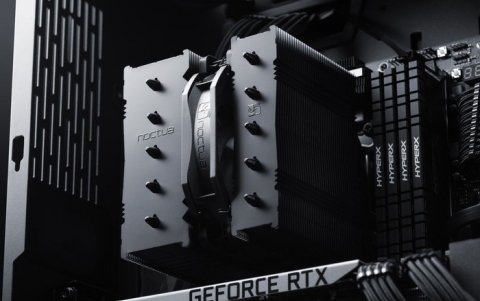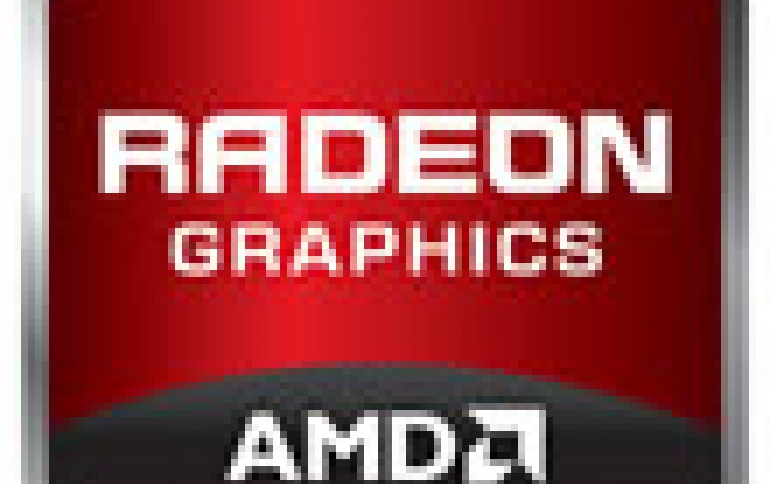
AMD Details R7 and R9 Series Of Video Cards
AMD has further detailed its upcoming GPU line, which includes the
entry-level R7 240 card, the double-wide R7 250 and R7 260X as well
as the R9 270X and R9 280X.
As we have previously seen with AMD's 2014 GPU lineup, the company is changing the naming of their products. The new naming scheme means
that names like Radeon HD 7970 GHz Edition and Radeon HD 7770 get
replaced with names like Radeon R9 280X and Radeon R7 260X. At launch
there will be the R9 and R7 categories, the former signifying AMD's
enthusiast level products, while the latter signifying AMD's
mainstream level products.

At the top will be the R9 290X, which will not be launching today, and below it we have the R9 280X, R9 270X, R7 260X, R7 250, and R7 240. The latter 5 cards are all launching this week and AMD has released the complete specifications, which you see below.
The entry-level R7 240 has 320 stream processors, with the clock speed of the card running at up to 780 MHz. The card will be available with either 1GB of GDDR5 or 2GB of DDR3 VRAM. Memory speed has been clocked at 4.6 Gbps. The card draws only 30 watts. Outputs are DVI-Dual Link, VGA, and HDMI 1.3.
The R7 250 is a double-wide card, with 384 stream processors. The engine clock peaks at 1.05GHz. Memory configurations are the same as the 240, with either 1GB of GDDR5 or 2GB of DDR3 VRAM and a 4.6Gbps memory speed. The board draws 65W of power. Outputs are DVI-Dual Link, VGA, and HDMI 1.3. The entry-level card will retail for less than $89, according to AMD.
The R7 260X card has 896 stream processors. At 1.1Ghz, the engine clock is a bit higher than the R7 250. Only one configuration of the card is available, and it has 2GB of of GDDR5 with 6.5Gbps of speed. A single six-pin power connector is required, as the card draws 115W of power. The card has one DVI-D port and one DVI dual link connector, a HDMI 1.3 port, and a DisplayPort. The R7 260X will sell for $139.
The fourth card released today is the R9 270X. The card has 1,280 stream processors, with the engine clock speed at 1.06GHz. Two configurations are available with 2GB or 4GB of GDDR5 installed, running at 5.6Gbps. Two six-pin power connectors are required, as the card draws 180W. Two DVI dual link ports, a HDMI port, and a DisplayPort provide monitor connectivity. The 2GB R9 270X is expected to retail for $199, with the R9 270X with 4GB available for $229.
Finally the R9 280X boasts 2,048 stream processors, with an engine clock up to 1GHz. The card mounts 3GB of GDDR5 memory, with a 6Gbps speed. The card draws 250W, and requires one six-pin, and one eight-pin power connector. As with the R9 270X, the R9 280X has Two DVI dual link ports, a HDMI port, and a DisplayPort provide monitor connectivity. The R9 280X will sell for $299.
The high-end Radeon R9 290X boasts 2,816 stream processors with up to a 1GHz GPU clock, computing performance of 5.6TFLOPS, and 4 GB of GDDR5 memory across a 512-bit wide memory interface, clocked at 5.00 GHz providing 320 GB/s of memory bandwidth.
The AMD Radeon R9 290 boasts 2,560 stream processors and a clock speed up to 947 MHz offering performance of 4.9 TFLOPS. It sticks with the same 4 GB of GDDR5 memory across a 512-bit wide memory interface as the top-end model and all other interfaces and specifications seem to be equal.
As you see, R9 290 aside, with the 200 series AMD is going to be issuing new SKUs for their existing GPUs - Southern Islands and Sea Islands.
The 2-year old Tahiti GPU is forming the basis of the R9 280X, in what's essentially a lower clocked 7970GHz Edition. Meanwhile the Pitcairn based 7870 gains PowerTune Boost capabilities and becomes the R9 270X, and the Bonaire based 7790 also gains boost capabilities while becoming the R7 260X. Finally Oland, finally gets a retail desktop release with the R7 250 and R7 240, both aimed at OEMs.
The R9 280X and R9270X are based on the original GCN architecture, while the Bonaire powered R7 260X is based on AMD?s revised GCN architecture.
All of the cards receive new firmware, which allow them to drive three displays (DVI/HDMI) off of one card. The R7 260X also gains audio capabilities via AMD's TrueAudio technology.
AMD's new software and technology initiatives for the upcoming year includes Mantle, AMD's low level graphics API for GCN. First announced at AMD's public GPU 2014 technology showcase, Mantle is a low level API designed to interact closely with AMD's GCN architecture GPUs, and in doing so will let them achieve greater performance than either Direct3D or OpenGL.

The first showcase game and engine for Mantle will be DICE's Battlefield 4, which will receive Mantle support in an update in December.
AMD will provide more details about Mantle next month at the 2013 AMD Developer Summit.
AMD's Display Technology group has been working on making improvements to Eyefinity surround setups. As is well known about the 7000 series, it was limited to 2 independent TMDS interface (DVI/HDMI) displays at once. Unlike the packet based DisplayPort interface, TMDS style interfaces adjust the clockspeed of the interface itself to match the needs of the display. As a result while you can drive a large number of DisplayPort interface monitors off of a single shared clock generator, you need a dedicated clock generator for each and every TMDS interface monitor. AMD only put 2 clock generators for TMDS interfaces on their silicon, hence they could only drive 2 such monitors at once.
With the 200 series this isn't changing but thanks to some firmware and board level changes, with the 200 series AMD is now able to attach multiple TMDS transmitters/interfaces to the same clock generator, allowing one clock generator to be used to drive multiple displays. As a result it?s now possible to drive up to 3 TMDS interface displays off of a single 200 series card, with restrictions.

The catch here is that these can?t be independent displays, and this change is primarily intended towards enabling Eyefinity with DVI/HDMI-only monitors. To utilize clock sharing and to drive 3 such monitors off of a single card, all 3 monitors must be timing-identical, which functionally speaking almost always requires the monitors to be completely identical. Furthermore the sharing of the clock generator can only be engaged/disabled upon boot, so the 3rd display cannot be hot-plugged and must be present at boot time. Consequently this is by no means as unrestricted and easy as having native support for 3 TMDS interface displays, but for Eyefinity it will get the job done.
Of course, using the DisplayPort, either with a native monitor or through an active DP-to-DVI/HDMI adapter, still allows the same fully independent functionality as before.
AMD is also rolling out support for VESA Display ID 1.3 in their newest drivers, for availability in the Radeon HD 7000 series and above. Display ID 1.3 formalizes support for tiled displays, which implement very high resolutions such as 4K in the form of multiple lower resolution tiles that identify and behave like separate monitors.
Ultimately tiled 4K displays are a transitionary technology as they?ll be replaced with native (single tile) 4K displays next year when suitable timing controllers hit the market, but in the interim Display ID 1.3 is the formal solution to that problem.
AMD has also plans for supporting native 4K @ 60Hz monitors in the future.
Finally, AMD?s Discrete Digital Multipoint Audio (DDMA) support is getting an upgrade. DDMA allows for audio-capable HDMI/DisplayPort monitors to coexist, and for each present themselves as an independent sound sink. The idea behind this technology is to enable uses where having discrete speakers dedicated to each monitor would come in handy, such as video conferencing.
The final technical announcement coming out of AMD?s 2014 GPU product showcase was TrueAudio. TrueAudio - enabled games can feature more realistic environmental dynamics, a wider array of sound effects, directional audio and more.
TrueAudio is a return to the concept of hardware accelerated audio processing. Hardware accelerated audio processing in the PC space essentially died with Windows Vista, which moved most of the Windows audio stack into software. Now you can still do advanced 3D audio and other effects in software by having the game engine itself do the work.
TrueAudio is also a new way for AMD to differentiate from Intel and NVIDIA. The feature is not going to be present on all 200 series cards. The functionality is limited to 260X and 290X. 280X, 270X.
For TrueAudio, AMD is taking Tensilica's HiFi EP DSPs and integrates them onto the die of their GPUs.
Tensilica's audio DSPs are programmable hardware allowing for customized effects and processing to be done while still keeping the size and power costs low. The underlying hardware is programmable in C, while AMD for their part will be providing a TrueAudio API to access the hardware with.
The trick here for AMD, more so than Mantle, is to get developers to put TrueAudio to use.

At the top will be the R9 290X, which will not be launching today, and below it we have the R9 280X, R9 270X, R7 260X, R7 250, and R7 240. The latter 5 cards are all launching this week and AMD has released the complete specifications, which you see below.
R9
290X |
R9
290 |
R9
280X |
R9
270X |
R9
270 |
R7
260X |
R7
260 |
R7
250 |
R7
240 |
|
| GPU Architecture | 28nm |
28nm |
28nm |
28nm |
28nm |
28nm |
28nm |
28nm |
28nm |
| API Support | DirectX 11.2, Mantle, OpenGL 4.3 | DirectX 11.2, Mantle, OpenGL 4.3 | DirectX 11.2, Mantle, OpenGL 4.3 | DirectX 11.2, Mantle, OpenGL 4.3 | DirectX 11.2, Mantle, OpenGL 4.3 | DirectX 11.2, Mantle, OpenGL 4.3 | DirectX 11.2, Mantle, OpenGL 4.3 | DirectX 11.2, Mantle, OpenGL 4.3 | DirectX 11.2, Mantle, OpenGL 4.3 |
| PCE Express Version | 3.0 | 3.0 | 3.0 | 3.0 | 3.0 | 3.0 | 3.0 | 3.0 | 3.0 |
| AMD PowerTune Technology | Yes | Yes | Yes | Yes | Yes | Yes | Yes | Yes | Yes |
| 4K Resolution Support | Yes | Yes | Yes | Yes | Yes | Yes | Yes | No | No |
| DDM Audio | Yes | Yes | Yes | Yes | Yes | Yes | Yes | Yes | Yes |
| HDMI (With 4K, Stereo 3D, Deep Color & x.v.Color) | Yes | Yes | Yes | Yes | Yes | Yes | Yes | Yes | Yes |
| TrueAudio Technology | Yes | Yes | No | No | No | Yes | Yes | No | No |
| AMD Eyefinity Technology (Maximum displays, 3-DVI Support yes/no) | 6, Yes | 6, Yes | 4, Yes | 4, Yes | 4, Yes | 4, Yes | 4, Yes | 1, Yes | 1, Yes |
| Video Codec Engine (VCE) Maximum Supported Streams and Supported Resolution and Frame Rate (with H.264, MPEG-4 ASP, MPEG-2, VC-1 & Blu-ray 3D) | Yes | Yes | Yes | Yes | Yes | Yes | Yes | Yes | Yes |
| GPU Clock Speed | Up to 1GHz | Up to 947GHz | Up to 1GHz | Up to 1.05GHz | Up to 925MHz | Up to 1.1GHz | Up to 1GHz | Up to 1.05GHz | Up to 780GHz |
| Memory Bandwidth | Up to 320 GB/s | Up to 320 GB/s | Up to 288 GB/s | Up to 104 GB/s | Up to 104 GB/s | Up to 104 GB/s | Up to 96 GB/s | Up to 72 GB/s | Up to 28.8-72 GB/s |
| Memory Amount | Up to 4GB GDDR5 | Up to 4GB GDDR5 | Up to 3GB GDDR5 | Up to 4GB GDDR5 | Up to 4GB GDDR5 | Up to 4GB GDDR5 | Up to 2GB GDDR5 | Up to 2GB GDDR5 or DDR3 | Up to 2GB GDDR5 or DDR3 |
| Compute performance | 5.6 TFLOPS | 4.9TFLOPS | 4.1 TFLOPS | 2.69 TFLOPS | 1.97 TFLOPS | 806 GFLOPS | 499 GFLOPS | ||
| Stream Processing Units | Up to 2816 | Up to 2560 | Up to 2816 | Up to 1280 | Up to 1280 | Up to 896 | Up to 768 | Up to 384 | Up to 320 |
| Required Power Supply Connectors | 1 x 6-pin + 1 x 8-pin | 1 x 6-pin + 1 x 8-pin | 1 x 6-pin + 1 x 8-pin | 2 x 6-pin | 1 x 6-pin | 1 x 6-pin | 1 x 6-pin | 1 x 6-pin | 1 x 6-pin |
| AMD CrossFire Support (Maximum number of GPUs and CrossFire Bridge Interconnect required) | 4, no | 4, no | 4, yes | 4, yes | 2, yes | 2, no | 2, no | 2, no | 2, no |
| Form Factor | Full height, dual slot | Full height, dual slot | Full height, dual slot | Full height, dual slot | Full height, dual slot | Full height, dual slot | Full height, dual slot | Full height, dual or single slot | Low profile, single slot |
| Price | $299 | $199 (2GB) $229 (4GB) |
$139 | $89 | $69 |
The entry-level R7 240 has 320 stream processors, with the clock speed of the card running at up to 780 MHz. The card will be available with either 1GB of GDDR5 or 2GB of DDR3 VRAM. Memory speed has been clocked at 4.6 Gbps. The card draws only 30 watts. Outputs are DVI-Dual Link, VGA, and HDMI 1.3.
The R7 250 is a double-wide card, with 384 stream processors. The engine clock peaks at 1.05GHz. Memory configurations are the same as the 240, with either 1GB of GDDR5 or 2GB of DDR3 VRAM and a 4.6Gbps memory speed. The board draws 65W of power. Outputs are DVI-Dual Link, VGA, and HDMI 1.3. The entry-level card will retail for less than $89, according to AMD.
The R7 260X card has 896 stream processors. At 1.1Ghz, the engine clock is a bit higher than the R7 250. Only one configuration of the card is available, and it has 2GB of of GDDR5 with 6.5Gbps of speed. A single six-pin power connector is required, as the card draws 115W of power. The card has one DVI-D port and one DVI dual link connector, a HDMI 1.3 port, and a DisplayPort. The R7 260X will sell for $139.
The fourth card released today is the R9 270X. The card has 1,280 stream processors, with the engine clock speed at 1.06GHz. Two configurations are available with 2GB or 4GB of GDDR5 installed, running at 5.6Gbps. Two six-pin power connectors are required, as the card draws 180W. Two DVI dual link ports, a HDMI port, and a DisplayPort provide monitor connectivity. The 2GB R9 270X is expected to retail for $199, with the R9 270X with 4GB available for $229.
Finally the R9 280X boasts 2,048 stream processors, with an engine clock up to 1GHz. The card mounts 3GB of GDDR5 memory, with a 6Gbps speed. The card draws 250W, and requires one six-pin, and one eight-pin power connector. As with the R9 270X, the R9 280X has Two DVI dual link ports, a HDMI port, and a DisplayPort provide monitor connectivity. The R9 280X will sell for $299.
The high-end Radeon R9 290X boasts 2,816 stream processors with up to a 1GHz GPU clock, computing performance of 5.6TFLOPS, and 4 GB of GDDR5 memory across a 512-bit wide memory interface, clocked at 5.00 GHz providing 320 GB/s of memory bandwidth.
The AMD Radeon R9 290 boasts 2,560 stream processors and a clock speed up to 947 MHz offering performance of 4.9 TFLOPS. It sticks with the same 4 GB of GDDR5 memory across a 512-bit wide memory interface as the top-end model and all other interfaces and specifications seem to be equal.
As you see, R9 290 aside, with the 200 series AMD is going to be issuing new SKUs for their existing GPUs - Southern Islands and Sea Islands.
The 2-year old Tahiti GPU is forming the basis of the R9 280X, in what's essentially a lower clocked 7970GHz Edition. Meanwhile the Pitcairn based 7870 gains PowerTune Boost capabilities and becomes the R9 270X, and the Bonaire based 7790 also gains boost capabilities while becoming the R7 260X. Finally Oland, finally gets a retail desktop release with the R7 250 and R7 240, both aimed at OEMs.
The R9 280X and R9270X are based on the original GCN architecture, while the Bonaire powered R7 260X is based on AMD?s revised GCN architecture.
All of the cards receive new firmware, which allow them to drive three displays (DVI/HDMI) off of one card. The R7 260X also gains audio capabilities via AMD's TrueAudio technology.
AMD's new software and technology initiatives for the upcoming year includes Mantle, AMD's low level graphics API for GCN. First announced at AMD's public GPU 2014 technology showcase, Mantle is a low level API designed to interact closely with AMD's GCN architecture GPUs, and in doing so will let them achieve greater performance than either Direct3D or OpenGL.

The first showcase game and engine for Mantle will be DICE's Battlefield 4, which will receive Mantle support in an update in December.
AMD will provide more details about Mantle next month at the 2013 AMD Developer Summit.
AMD's Display Technology group has been working on making improvements to Eyefinity surround setups. As is well known about the 7000 series, it was limited to 2 independent TMDS interface (DVI/HDMI) displays at once. Unlike the packet based DisplayPort interface, TMDS style interfaces adjust the clockspeed of the interface itself to match the needs of the display. As a result while you can drive a large number of DisplayPort interface monitors off of a single shared clock generator, you need a dedicated clock generator for each and every TMDS interface monitor. AMD only put 2 clock generators for TMDS interfaces on their silicon, hence they could only drive 2 such monitors at once.
With the 200 series this isn't changing but thanks to some firmware and board level changes, with the 200 series AMD is now able to attach multiple TMDS transmitters/interfaces to the same clock generator, allowing one clock generator to be used to drive multiple displays. As a result it?s now possible to drive up to 3 TMDS interface displays off of a single 200 series card, with restrictions.

The catch here is that these can?t be independent displays, and this change is primarily intended towards enabling Eyefinity with DVI/HDMI-only monitors. To utilize clock sharing and to drive 3 such monitors off of a single card, all 3 monitors must be timing-identical, which functionally speaking almost always requires the monitors to be completely identical. Furthermore the sharing of the clock generator can only be engaged/disabled upon boot, so the 3rd display cannot be hot-plugged and must be present at boot time. Consequently this is by no means as unrestricted and easy as having native support for 3 TMDS interface displays, but for Eyefinity it will get the job done.
Of course, using the DisplayPort, either with a native monitor or through an active DP-to-DVI/HDMI adapter, still allows the same fully independent functionality as before.
AMD is also rolling out support for VESA Display ID 1.3 in their newest drivers, for availability in the Radeon HD 7000 series and above. Display ID 1.3 formalizes support for tiled displays, which implement very high resolutions such as 4K in the form of multiple lower resolution tiles that identify and behave like separate monitors.
Ultimately tiled 4K displays are a transitionary technology as they?ll be replaced with native (single tile) 4K displays next year when suitable timing controllers hit the market, but in the interim Display ID 1.3 is the formal solution to that problem.
AMD has also plans for supporting native 4K @ 60Hz monitors in the future.
Finally, AMD?s Discrete Digital Multipoint Audio (DDMA) support is getting an upgrade. DDMA allows for audio-capable HDMI/DisplayPort monitors to coexist, and for each present themselves as an independent sound sink. The idea behind this technology is to enable uses where having discrete speakers dedicated to each monitor would come in handy, such as video conferencing.
The final technical announcement coming out of AMD?s 2014 GPU product showcase was TrueAudio. TrueAudio - enabled games can feature more realistic environmental dynamics, a wider array of sound effects, directional audio and more.
TrueAudio is a return to the concept of hardware accelerated audio processing. Hardware accelerated audio processing in the PC space essentially died with Windows Vista, which moved most of the Windows audio stack into software. Now you can still do advanced 3D audio and other effects in software by having the game engine itself do the work.
TrueAudio is also a new way for AMD to differentiate from Intel and NVIDIA. The feature is not going to be present on all 200 series cards. The functionality is limited to 260X and 290X. 280X, 270X.
For TrueAudio, AMD is taking Tensilica's HiFi EP DSPs and integrates them onto the die of their GPUs.
Tensilica's audio DSPs are programmable hardware allowing for customized effects and processing to be done while still keeping the size and power costs low. The underlying hardware is programmable in C, while AMD for their part will be providing a TrueAudio API to access the hardware with.
The trick here for AMD, more so than Mantle, is to get developers to put TrueAudio to use.




